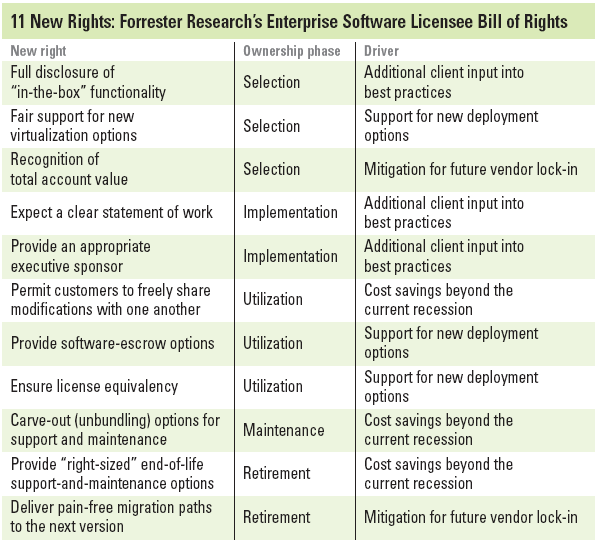Stand Up for Your Rights!
For the rest of the September 2009 issue of CRM magazine please click here.
Of all the assets that an enterprise acquires, software brings the most unusual, onerous, and restrictive set of ownership constraints. Think about it: Not only are licensees precluded from reselling, reusing, or sharing their licenses, but they also often encounter numerous grievances across the five phases of the software ownership life cycle, from selection and implementation to utilization and maintenance, and on into retirement. These grievances, however, can be foreseen and addressed during enterprise-software strategy development and contract negotiations with vendors.
To re-establish ownership rights, remedy past grievances, and regain power, a Licensee Bill of Rights -- based on the ownership life cycle -- should become part of vendor-client arrangements. Customers should push for these rights regarding how software should be owned and how licensees should be treated. [Editors' Note: For a graphic representation of the Licensee Bill of Rights and the ownership life cycle, click here.]
Changing market conditions often lead to the emergence of new rights. Poor economic conditions may have kept vendors from raising prices for now, but rapid vendor consolidation has eliminated choice and customer leverage in the market. Upon economic recovery, enterprises can expect price increases in software categories where only a handful of providers compete.
Fortunately, advances in deployment (e.g., software-as-a-service [SaaS], platform-as-a-service, cloud computing, managed services, and virtualization) may slowly shift the pendulum in favor of the customer. A recent poll generated nearly 200 end-user and vendor responses and suggestions for an update to our Licensee Bill of Rights, and each of the 11 additional rights (see chart, below) was driven by one of four main themes:
Support for new deployment options. SaaS and virtualization are moving from interesting concepts to mainstream options. Users should expect to achieve savings in virtualized instances, protection from SaaS-vendor bankruptcies, and the ability to swap user and usage rights among new deployment options. Three new rights around these issues are: support for virtualization options, escrow options for SaaS deployments, and license equivalency among different usage and utilization options.
Cost savings beyond the current recession. Renewed focus on cost reduction is driving CIOs and business and technology professionals to identify short- and long-term opportunities for choice, value, and predictability in vendors' support-and-maintenance programs. These include carve-out options and right-sized end-of-life options, as well as the ability for customers to share modifications with each other.
Mitigation for future vendor lock-in in a less-competitive environment. Rapid consolidation among vendors leaves many sectors with significantly fewer options. Users want leverage in contract negotiations beyond the initial purchase, including recognition of total account value; pain-free migration paths to future software updates; and new wording to maintain third-party maintenance rights.
Additional client input into best practices. More than 50 clients provided suggestions for improvements in the early phases of the ownership life cycle, including, in the selection phase, full disclosure of "in-the-box" functionality, and, in the implementation phase, the expectation of a clear statement of work and the provision of an appropriate executive sponsor.

[Source: Forrester Research]
Incorporate these best practices into your vendor relationships and your strategies for contracts and packaged applications. The following seven steps will help you negotiate software contracts while building a long-term strategy for CRM applications:
1. Assemble the right team. Include key business and technology leaders, vendor management experts, and legal advisors. If applicable, work with a third-party advisor or trusted expert who can provide insight on the latest pricing trends, concessions in licensing and pricing policies, and vendor relationships. Include the right team from the vendor. Ensure that their account quotas and objectives are aligned with yours.
2. Identify business drivers. Contract-negotiation strategies require alignment with business drivers, but because those drivers often shift with time, the portfolio of initiatives requires organization and alignment by economic state and project risk. Projects will fall into four main areas: compliance, efficiency, growth, and strategy.
3. Apply the software-ownership life cycle and the Licensee Bill of Rights. Put the bill of rights to use, and keep the five phases of the ownership life cycle in mind. Unexpected costs during selection often include platform-, connection-, and country-support charges. During implementation, customers may see costs for performance, integration, and security requirements. Surprises during utilization often include fees for bandwidth, storage, and additional modules. Maintenance charges could include backup recovery. Retirement includes switching costs such as data or process migration, training, and integration.
4. Determine the product-adoption plan. Review adoption plans to determine actual requirements. Validate the vendor's roadmap with key business drivers. Identify overall implementation roadmaps. Product-adoption strategy is the differentiator in contract negotiations, so have your teams for sourcing and vendor management work with product experts who also understand contract strategy.
5. Align product-adoption strategy with contract-negotiation objectives. Business and technology roles must provide realistic time frames for product adoption to set contract-negotiation objectives such as flex-up/flexdown provisions, maintenance reductions, inputs into product direction, and long-term usage optimizations.
6. Identify main leverage points. Prioritize the list of negotiation points for terms and conditions. Target objectives for user- and usage-based license costs. Inventory relevant products with an eye toward total spending.
7. Finalize the negotiation strategy. Bring all the elements together to craft the final plan. Gather agreement from key stakeholders. Prepare for contingencies and emergency scenarios by role-playing negotiations.
R "Ray" Wang (r@altimetergroup.com), a partner at Altimeter Group, focuses on the emerging class of business solutions adopting the spirit of social technologies and concepts. His research spans enterprise resource planning, CRM, project-based solutions, order management, master data management, and software-as-a-service. (The research on which this column is based was conducted during Wang's tenure as a vice president and principal analyst at Forrester Research.) He can be found on Twitter as @rwang0 and regularly blogs at http://blog.softwareinsider.org. .